
The sterile insect technique (SIT) is a method of biological insect control, whereby overwhelming numbers of sterile insects are released into the wild. The released insects are preferably male, as this is more cost-effective and the females may in some situations cause damage by laying eggs in the crop, or, in the case of mosquitoes, taking blood from humans. The sterile males compete with fertile males to mate with the females. Females that mate with a sterile male produce no offspring, thus reducing the next generation's population. Sterile insects are not self-replicating and, therefore, cannot become established in the environment. Repeated release of sterile males over low population densities can further reduce and in cases of isolation eliminate pest populations, although cost-effective control with dense target populations is subjected to population suppression prior to the release of the sterile males.

The Tephritidae are one of two fly families referred to as fruit flies, the other family being the Drosophilidae. The family Tephritidae does not include the biological model organisms of the genus Drosophila, which is often called the "common fruit fly". Nearly 5,000 described species of tephritid fruit fly are categorized in almost 500 genera of the Tephritidae. Description, recategorization, and genetic analyses are constantly changing the taxonomy of this family. To distinguish them from the Drosophilidae, the Tephritidae are sometimes called peacock flies, in reference to their elaborate and colorful markings. The name comes from the Greek τεφρος, tephros, meaning "ash grey". They are found in all the biogeographic realms.
A semiochemical, from the Greek σημεῖον (semeion), meaning "signal", is a chemical substance or mixture released by an organism that affects the behaviors of other individuals. Semiochemical communication can be divided into two broad classes: communication between individuals of the same species (intraspecific) or communication between different species (interspecific).

The Tephritoidea are a superfamily of flies. It has over 7,800 species, the majority of them in family Tephritidae.
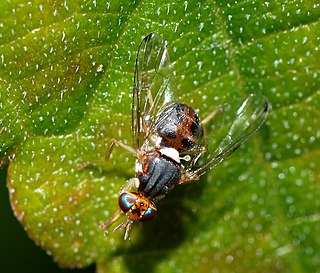
The olive fruit fly is a species of fruit fly which belongs to the subfamily Dacinae. It is a phytophagous species whose larvae feed on the fruit of olive trees, hence the common name. It is considered a serious pest in the cultivation of olives.
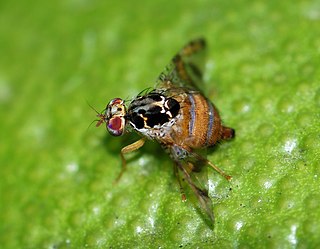
Ceratitis capitata, commonly known as the Mediterranean fruit fly or medfly, is a yellow-and-brown fly native to sub-Saharan Africa. It has no near relatives in the Western Hemisphere and is considered to be one of the most destructive fruit pests in the world. There have been occasional medfly infestations in California, Florida, and Texas that require extensive eradication efforts to prevent the fly from establishing itself in the United States.
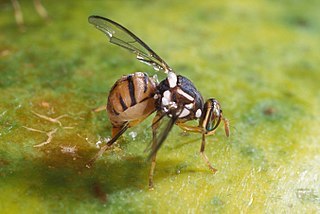
Bactrocera is a large genus of tephritid fruit flies, with close to 500 species currently described and accepted.

Bactrocera dorsalis, previously known as Dacus dorsalis and commonly referred to as the oriental fruit fly, is a species of tephritid fruit fly that is endemic to Southeast Asia. It is one of the major pest species in the genus Bactrocera with a broad host range of cultivated and wild fruits. Male B. dorsalis respond strongly to methyl eugenol, which is used to monitor and estimate populations, as well as to annihilate males as a form of pest control. They are also important pollinators and visitors of wild orchids, Bulbophyllum cheiri and Bulbophyllum vinaceum in Southeast Asia, which lure the flies using methyl eugenol.

The Tephritid Workers Database is a web-based database for sharing information on tephritid fruit flies. Because these species are one of the most economically important group of insect species that threaten fruit and vegetable production and trade worldwide, a tremendous amount of information is made available each year: new technologies developed, new information on their biology and ecology; new control methods made available, new species identified, new outbreaks recorded and new operational control programmes launched. The TWD allows workers to keep up-to-date on the most recent developments and provides an easily accessible and always available resource.
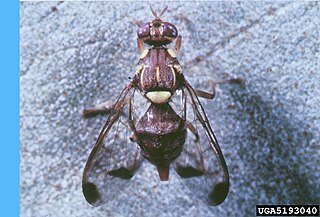
Bactrocera cucurbitae, the melon fly, is a fruit fly of the family Tephritidae. It is a serious agricultural pest, particularly in Hawaii.

Anastrepha is the most diverse genus in the American tropics and subtropics. Currently, it comprises more than 300 described species, including nine major pest species, such as the Mexican fruit fly, the South American fruit fly, the West Indian fruit fly, the sapote fruit fly, the Caribbean fruit fly, the American guava fruit fly, and the pumpkin fruit fly, as well as the papaya fruit fly. As some of their names suggest, these pest species are one of the most numerous and damaging groups of insects in their native range, plaguing commercial fruits such as citrus, mango, guava, and papaya.

Anastrepha ludens, the Mexican fruit fly or Mexfly, is a species of fly of the Anastrepha genus in the Tephritidae family. It is closely related to the Caribbean fruit fly Anastrepha suspensa, and the papaya fruit fly Anastrepha curvicauda.
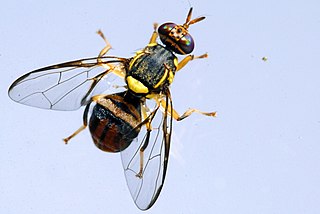
Bactrocera (Bactrocera) invadens is the name given to tephritid fruit flies that were introduced to East Africa from Sri Lanka and subsequently invaded practically the whole of Sub-Saharan Africa, hence the species name "invadens". It was first shown to be the same biological species as B. dorsalis s.s. by possessing identical sex pheromonal components after consumption of methyl eugenol, and also based on CO1 and rDNA sequences. Subsequently, it was agreed that B. invadens, B. papayae and B. philippinensis be synonymized as B. dorsalis. To counteract its detrimental effects to the fruit business, the industry resorts to cold treatment in order to get rid of the larvae.
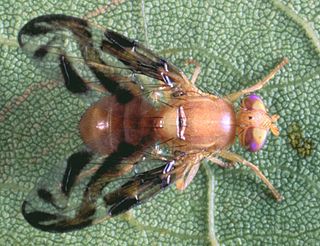
Anastrepha suspensa, known as the Caribbean fruit fly, the Greater Antillean fruit fly, guava fruit fly, or the Caribfly, is a species of tephritid fruit fly. As the names suggest, these flies feed on and develop in a variety of fruits, primarily in the Caribbean. They mainly infest mature to overripe fruits. While thought to have originated in Cuba, the Caribbean fruit fly can now also be found in Florida, Hispaniola, and Puerto Rico.
An attractant is any chemical that attracts an organism, e.g. i) synthetic lures; ii) aggregation and sex pheromones ; and iii) synomone

Bactrocera carambolae, also known as the carambola fruit fly, is a fruit fly species in the family Tephritidae, and is native to Asia. This species was described by Drew and Hancock in 1994.
Ronald John Prokopy was an American entomologist who was a specialist on the behavior and biology of Rhagoletis flies and approaches to their management in apple orchards.
Bactrocera passiflorae, the Fijian fruit fly, is a species of fly in the family Tephritidae in the insect order Diptera. It is native to several tropical and subtropical islands in the Pacific Ocean and is a pest of fruit crops.

Anastrepha fraterculus, known as the South American fruit fly, is a fruit fly species from the genus Anastrepha. A. fraterculus is a polyphagous, frugivorous fly that is a significant pest of commercial fruit production in South America.














